Hydrological Modeling of the Chikugo River Basin Using SWAT: Insights into Water Balance and Seasonal Variability
Abstract
1. Introduction
2. Materials and Methods
2.1. Study Area
2.2. General Data Processing
2.3. Model Performance and Sensitivity Analysis
2.4. Principal Component Analysis of Land Use, Soil Type, and Slope Band on Water Balance
2.5. Assessment of Water Supply, Demographic Trends, and Domestic Water Demand
3. Results and Discussion
3.1. Model Performance and Uncertainty Analyses
3.2. Sensitive Parameter Analysis
3.3. Analysis of Annual Water Balance Components
3.4. Analysis of Seasonal Variation of Water Balance Components
3.5. Relationship Between Land Use, Soil Type, and Slope Band on Water Balance
3.6. Domestic Water Use for Sustainable Water Resource Management
4. Conclusions
Supplementary Materials
Author Contributions
Funding
Institutional Review Board Statement
Informed Consent Statement
Data Availability Statement
Acknowledgments
Conflicts of Interest
References
- van Vliet, M.T.H.; Jones, E.R.; Flörke, M.; Franssen, W.H.P.; Hanasaki, N.; Wada, Y.; Yearsley, J.R. Global Water Scarcity Including Surface Water Quality and Expansions of Clean Water Technologies. Environ. Res. Lett. 2021, 16, 024020. [Google Scholar] [CrossRef]
- Han, Z.Y.; Han, P.F.; Huang, Q.; Du, M.D.; Hou, A.Z. An Improved Modeling of Precipitation Phase and Snow in the Lancang River Basin in Southwest China. Sci. China Technol. Sci. 2021, 64, 1513–1527. [Google Scholar] [CrossRef]
- Kamamia, A.W.; Vogel, C.; Mwangi, H.M.; Feger, K.H.; Sang, J.; Julich, S. Using Soil Erosion as an Indicator for Integrated Water Resources Management: A Case Study of Ruiru Drinking Water Reservoir, Kenya. Environ. Earth Sci. 2022, 81, 502. [Google Scholar] [CrossRef]
- Safeeq, M.; Bart, R.R.; Pelak, N.F.; Singh, C.K.; Dralle, D.N.; Hartsough, P.; Wagenbrenner, J.W. How Realistic Are Water-Balance Closure Assumptions? A Demonstration From the Southern Sierra Critical Zone Observatory and King’s River Experimental Watersheds. Hydrol. Process. 2021, 35, e14199. [Google Scholar] [CrossRef]
- Gupta, L.; Dixit, J. Estimation of Rainfall-Induced Surface Runoff for the Assam Region, India, Using the GIS-Based NRCS-CN Method. J. Maps 2022, 18, 428–440. [Google Scholar] [CrossRef]
- Ding, T.; Gao, H. The Record-Breaking Extreme Drought in Yunnan Province, Southwest China During Spring-Early Summer of 2019 and Possible Causes. J. Meteorol. Res. 2020, 34, 997–1012. [Google Scholar] [CrossRef]
- Sinclair, S.; Pegram, G.G.S. A Comparison of ASCAT and Modelled Soil Moisture Over South Africa, Using TOPKAPI in Land Surface Mode. Hydrol. Earth Syst. Sci. 2010, 14, 613–626. [Google Scholar] [CrossRef]
- Arnold, J.G.; Kiniry, J.R.; Srinivasan, R.; Williams, J.R.; Haney, E.B.; Neitsch, S.L. Soil and Water Assessment Tool. In Theoretical Documentation Version 2009; Technical Report No. 406; Texas Water Resources Institute, Texas A&M University: College Station, TX, USA, 2011; Available online: https://www.researchgate.net/publication/306205252 (accessed on 5 January 2025).
- Halwatura, D.; Najim, M.M.M. Application of the HEC-HMS Model for Runoff Simulation in a Tropical Catchment. Environ. Model. Softw. 2013, 46, 155–162. [Google Scholar] [CrossRef]
- Tan, M.L.; Gassman, P.W.; Yang, X.; Haywood, J. A Review of SWAT Applications, Performance and Future Needs for Simulation of Hydro-Climatic Extremes. Adv. Water Resour. 2020, 143, 103662. [Google Scholar] [CrossRef]
- Wang, K.; Onodera, S.I.; Saito, M. Evaluation of Nitrogen Loading in the Last 80 Years in an Urbanized Asian Coastal Catchment Through the Reconstruction of Severe Contamination Period. Environ. Res. Lett. 2022, 17, 014010. [Google Scholar] [CrossRef]
- Wang, K.; Onodera, S.I.; Saito, M.; Ishida, T. Assessment of Long-Term Phosphorus Budget Changes Influenced by Anthropogenic Factors in a Coastal Catchment of Osaka Bay. Sci. Total Environ. 2022, 843, 156833. [Google Scholar] [CrossRef]
- Neitsch, S.L.; Arnold, J.G.; Kiniry, J.R.; Williams, J.R. Soil & Water Assessment Tool: Theoretical Documentation Version 2009; Texas Water Resources Institute: College Station, TX, USA, 2011; Available online: https://swat.tamu.edu/media/99192/swat2009-theory.pdf (accessed on 8 January 2025).
- Chinh, L.V.; Iseri, H.; Hiramatsu, K.; Harada, M.; Mori, M. Simulation of Rainfall Runoff and Pollutant Load for Chikugo River Basin in Japan Using a GIS-Based Distributed Parameter Model. Paddy Water Environ. 2013, 11, 97–112. [Google Scholar] [CrossRef]
- Dile, Y.T.; Daggupati, P.; George, C.; Srinivasan, R.; Arnold, J. Introducing a New Open Source GIS User Interface for the SWAT Model. Environ. Model. Softw. 2016, 85, 129–138. [Google Scholar] [CrossRef]
- Azhikodan, G.; Yokoyama, K. Seasonal Morphodynamic Evolution in a Meandering Channel of Macrotidal Estuary. Sci. Total Environ. 2019, 684, 281–295. [Google Scholar] [CrossRef]
- Suzuki, K.W.; Nakayama, K.; Tanaka, M. Horizontal Distribution and Population Dynamics of the Dominant Mysid Hyperacanthomysis longirostris Along a Temperate Macrotidal Estuary (Chikugo River Estuary, Japan). Estuar. Coast. Shelf Sci. 2009, 83, 516–528. [Google Scholar] [CrossRef]
- Saquib, S.; Gupta, A.; Joshi, A. Emerging Water Crisis: Impact of Urbanization on Water Resources and Constructed Wetlands as a Nature-Based Solution (NbS). Curr. Dir. Water Scarcity Res. 2022, 6, 447–468. [Google Scholar] [CrossRef]
- U.S. Geological Survey. Earth Explorer; Department of the Interior: Reston, VA, USA, 2023. Available online: https://earthexplorer.usgs.gov/ (accessed on 20 October 2023).
- Ministry of Land, Infrastructure, Transport and Tourism. Land Classif. Surv. Data [Shapefile]; Ministry of Land, Infrastructure, Transport and Tourism: Tokyo, Japan, 2023. Available online: https://nlftp.mlit.go.jp/kokjo/inspect/landclassification/download.html (accessed on 24 November 2023).
- Ministry of Land, Infrastructure, Transport and Tourism. Land Use Subdivision Mesh Data (L03-b); Ministry of Land, Infrastructure, Transport and Tourism: Tokyo, Japan, 2023. Available online: https://nlftp.mlit.go.jp/ksj/gml/datalist/KsjTmplt-L03-b-v3_1.html (accessed on 24 November 2023).
- Japan Meteorological Agency. Weather Map and AMeDAS Observation Data; Japan Meteorological Agency: Tokyo, Japan, 2023. Available online: https://www.jma.go.jp/jma/index.html (accessed on 24 November 2023).
- Ministry of Land, Infrastructure, Transport and Tourism. Water Level Obs. Site Inf. [CSV/Excel]; Ministry of Land, Infrastructure, Transport and Tourism: Tokyo, Japan, 2023. Available online: http://www1.river.go.jp/cgi-bin/SiteInfo.exe?ID=309061289901190 (accessed on 24 November 2023).
- Abbaspour, K.C.; Vejdani, M.; Haghighat, S.; Yang, J. SWAT-CUP Calibration and Uncertainty Programs for SWAT. In Proceedings of the MODSIM 2007 International Congress on Modelling and Simulation, Christchurch, New Zealand, 10–13 December 2007; pp. 1596–1602. Available online: https://scholar.google.com/scholar?cluster=7621557009645148872 (accessed on 5 September 2024).
- Hargreaves, G.H.; Samani, Z.A. Estimating Potential Evapotranspiration. J. Irrig. Drain. Eng. 1982, 108, 223–230. [Google Scholar] [CrossRef]
- Arnold, J.G.; Moriasi, D.N.; Gassman, P.W.; Abbaspour, K.C.; White, M.J.; Srinivasan, R.; Santhi, C.; Harmel, D.; van Griensven, A.; Van Liew, M.W.; et al. SWAT: Model Use Calibration Validation. Trans. ASABE 2012, 55, 1491–1508. [Google Scholar] [CrossRef]
- Moriasi, D.N.; Arnold, J.G.; Van Liew, M.W.; Bingner, R.L.; Harmel, D.R.; Veith, T.L. Model Evaluation Guidelines for Systematic Quantification of Accuracy in Watershed Simulations. Trans. ASABE 2007, 50, 885–900. Available online: https://swat.tamu.edu/media/1312/moriasimodeleval.pdf (accessed on 15 May 2024). [CrossRef]
- Abdi, H.; Williams, L.J. Principal Component Analysis. Wiley Interdiscip. Rev. Comput. Stat. 2010, 2, 433–459. [Google Scholar] [CrossRef]
- Ministry of Land, Infrastructure, Transport and Tourism. Water Resour. Data Summ. [Excel File]; Ministry of Land, Infrastructure, Transport and Tourism: Tokyo, Japan, 2023. Available online: https://view.officeapps.live.com/op/view.aspx?src=https%3A%2F%2Fwww.mlit.go.jp%2Fmizukokudo%2Fmizsei%2Fcontent%2F001593175.xlsx (accessed on 2 February 2025).
- Wang, K.; Onodera, S.I.; Saito, M.; Okuda, N.; Okubo, T. Estimation of Phosphorus Transport Influenced by Climate Change in a Rice Paddy Catchment Using SWAT. Int. J. Environ. Res. 2021, 15, 759–772. [Google Scholar] [CrossRef]
- Japan Society of Civil Engineers. Heisei 29 July Kyushu Northern Heavy Rain Disaster Investigation Report; Japan Society of Civil Engineers: Tokyo, Japan, 2020; Available online: https://committees.jsce.or.jp/report/node/209 (accessed on 18 March 2025).
- Phyu, P.E.; Azhikodan, G.; Yokoyama, K. Effects of Past Human Activities and Recent Disasters on Riverbed Morphology of the Chikugo River Estuary. J. JSCE 2024, 12, 23–16019. [Google Scholar] [CrossRef]
- Kibet, K.B.; Takeuchi, J.; Fujihara, M. Applicability of SWAT Model for Streamflow Simulation in a Highly Managed Agricultural Watershed. J. Rainwater Catchment Syst. 2018, 23, 19–29. Available online: https://www.jstage.jst.go.jp/article/jrcsa/23/2/23_23_2_19/_pdf/-char/ja (accessed on 25 March 2025). [CrossRef] [PubMed]
- Wang, K.; Onodera, S.I.; Saito, M.; Shimizu, Y. Assessment of Nitrogen Budget in Detailed Spatial Pattern Using High Precision Modeling Approach With Constructed Accurate Agricultural Behavior. Sci. Total Environ. 2024, 912, 169631. [Google Scholar] [CrossRef]
- King, K.W.; Arnold, J.G.; Bingner, R.L. Comparison of Green-Ampt and Curve Number Methods on Goodwin Creek Watershed Using SWAT. Trans. ASAE 1999, 42, 919–925. [Google Scholar] [CrossRef]
- Schlef, K.E.; François, B.; Brown, C. Comparing Flood Projection Approaches Across Hydro-Climatologically Diverse United States River Basins. Water Resour. Res. 2021, 57, e2019WR025861. [Google Scholar] [CrossRef]
- Boithias, L.; Sauvage, S.; Lenica, A.; Roux, H.; Abbaspour, K.; Larnier, K.; Dartus, D.; Perez, J.M.S. Simulating Flash Floods at Hourly Time-Step Using the SWAT Model. Water 2017, 9, 929. [Google Scholar] [CrossRef]
- Lee, J.; Kim, S.; Park, J.; Arnold, J.G. Enhancing Sustainability in Watershed Management: Spatiotemporal Assessment of Baseflow Alpha Factor in SWAT. Sustainability 2024, 16, 9189. [Google Scholar] [CrossRef]
- Sharma, R.; Singh, S. Streamflow and Sediment Simulation in the Song River Basin Using SWAT. Front. Water 2025, 3, 1500086. [Google Scholar] [CrossRef]
- Aboelnour, M.; Gitau, M.W.; Engel, B.A. A Comparison of Streamflow and Baseflow Responses to Land-Use Change and the Variation in Climate Parameters Using SWAT. Water 2020, 12, 191. [Google Scholar] [CrossRef]
- Kubota, S.; Nishida, K.; Yoshida, S. Plant Hydraulic Resistance Controls Transpiration of Soybean in Rotational Paddy Fields Under Humid Climates. Paddy Water Environ. 2023, 21, 219–230. [Google Scholar] [CrossRef]
- Lu, Z.; Feng, Q.; Xie, J.; Yin, Z.; Zhu, M.; Xu, M. The Reallocation of Water and Ecosystem Service Values in Arid Ecosystems With the Implementation of an Ecological Water Diversion Project. Appl. Water Sci. 2023, 13, 93. [Google Scholar] [CrossRef]
- Wu, D.; Fang, S.; Tong, X.; Wang, L.; Zhuo, W.; Pei, Z.; Wu, Y.; Zhang, J.; Li, M. Analysis of Variation in Reference Evapotranspiration and Its Driving Factors in Mainland China From 1960 to 2016. Environ. Res. Lett. 2021, 16, 054016. [Google Scholar] [CrossRef]
- Lo, M.-H.; Wey, H.-W.; Im, E.-S.; Tang, L.I.; Anderson, R.G.; Wu, R.-J.; Chien, R.-Y.; Wei, J.f.; AghaKouchak, A.; Wada, Y. Intense Agricultural Irrigation Induced Contrasting Precipitation Changes in Saudi Arabia. Environ. Res. Lett. 2021, 16, 064049. [Google Scholar] [CrossRef]
- Scanlon, B.R.; Rateb, A.; Pool, D.R.; Sanford, W.; Save, H.; Sun, A.; Long, D.; Fuchs, B. Effects of Climate and Irrigation on GRACE-Based Estimates of Water Storage Changes in Major US Aquifers. Environ. Res. Lett. 2021, 16, 094009. [Google Scholar] [CrossRef]
- Xiong, J.; Abhishek, Y.; Xu, L.; Chandanpurkar, H.A.; Famiglietti, J.S.; Zhang, C.; Ghiggi, G.; Guo, S.; Pan, Y.; Vishwakarma, B.D. ET-WB: Water Balance-Based Estimations of Terrestrial Evaporation Over Global Land and Major Global Basins. arXiv 2023, arXiv:2305.08881. [Google Scholar] [CrossRef]
- Yi, W.; Feng, Y.; Liang, S.; Kuang, X.; Yan, D.; Wan, L. Increasing Annual Streamflow and Groundwater Storage in Response to Climate Warming in the Yangtze River Source Region. Environ. Res. Lett. 2021, 16, 084011. [Google Scholar] [CrossRef]
- Wang, K.; Onodera, S.I.; Saito, M.; Shimizu, Y.; Iwata, T. Effects of Forest Growth in Different Vegetation Communities on Forest Catchment Water Balance. Sci. Total Environ. 2022, 809, 151159. [Google Scholar] [CrossRef] [PubMed]
- Kebede, S.; Charles, K.; Godfrey, S.; MacDonald, A.; Taylor, R. Regional-Scale Interactions Between Groundwater and Surface Water Under Changing Aridity: Evidence From the River Awash Basin, Ethiopia. Hydrol. Sci. J. 2021, 66, 450–463. [Google Scholar] [CrossRef]
- Xu, L.; Sun, S.; Chen, H.; Chai, H.; Wang, R.; Zhou, Y.; Ma, Q.; Chotamonsak, C.; Wangpakapattanawong, P. Changes in the Reference Evapotranspiration and Contributions of Climate Factors Over the Indo–China Peninsula During 1961–2017. Int. J. Climatol. 2021, 41, 6511–6529. [Google Scholar] [CrossRef]
- KanthaRao, B.; Rakesh, V. Observational Evidence for the Relationship Between Spring Soil Moisture and June Rainfall Over the Indian Region. Theor. Appl. Climatol. 2017, 132, 835–849. [Google Scholar] [CrossRef]
- Matheswaran, K.; Khadka, A.; Dhaubanjar, S.; Bharati, L.; Kumar, S.; Shrestha, S. Delineation of Spring Recharge Zones Using Environmental Isotopes to Support Climate-Resilient Interventions in Two Mountainous Catchments in Far-Western Nepal. Hydrogeol. J. 2019, 27, 2181–2197. [Google Scholar] [CrossRef]
- Rezaei, A. Chemistry of the Karst Sarabkalan Spring, Iran, and Controls of PDO and ENSO Climate Indices on It. Groundwater 2020, 59, 236–244. [Google Scholar] [CrossRef] [PubMed]
- Ferede, M.; Haile, A.T.; Walker, D.; Gowing, J.; Parkin, G. Multi-Method Groundwater Recharge Estimation at Eshito Micro-Watershed, Rift Valley Basin in Ethiopia. Hydrol. Sci. J. 2020, 65, 1596–1605. [Google Scholar] [CrossRef]
- Harrison, H.; Hammond, J.C.; Kampf, S.; Kiewiet, L. On the Hydrological Difference Between Catchments Above and Below the Intermittent-Persistent Snow Transition. Hydrol. Process. 2021, 35, e14411. [Google Scholar] [CrossRef]
- Wang, K.; Onodera, S.I.; Saito, M.; Shimizu, Y. Long-Term Variations in Water Balance by Increase in Percent Imperviousness of Urban Regions. J. Hydrol. 2021, 602, 126767. [Google Scholar] [CrossRef]
- Trancoso, R.; Larsen, J.R.; McVicar, T.R.; Phinn, S.R.; McAlpine, C.A. CO2-Vegetation Feedback and Other Climate Changes Implicated in Reducing Base Flow. Geophys. Res. Lett. 2017, 44, 2310–2318. [Google Scholar] [CrossRef]
- Sabathier, R.; Ainger, M.B.; Stella, J.C.; Roberts, D.A.; Caylor, K.K.; Jaeger, K.L.; Olden, J.D. High Resolution Spatiotemporal Patterns of Flow at the Landscape Scale in Montane Non-Perennial Streams. River Res. Appl. 2022, 39, 225–240. [Google Scholar] [CrossRef]
- Nang, Y.W.; Onodera, S.I.; Wang, K.; Shimizu, Y.; Saito, M. Slope Gradient Effects on Sediment Yield of Different Land Cover and Soil Types. Water 2024, 16, 1419. [Google Scholar] [CrossRef]
- Guyo, R.H.; Wang, K.; Saito, M.; Onodera, S.; Shimizu, Y.; Moroizumi, T. Spatiotemporal Shallow and Deep Groundwater Dynamics in a Forested Mountain Catchment with Diverse Slope Gradients, Western Japan. Groundw. Sustain. Dev. 2024, 25, 101150. [Google Scholar] [CrossRef]
- Weatherl, R.K.; Helanao Salgado, M.J.; Ramgraber, M.; Moeck, C.; Schirmer, M. Estimating surface runoff and groundwater recharge in an urban catchment using a water balance approach. Hydrogeol. J. 2021, 29, 2411–2428. [Google Scholar] [CrossRef]
- Emre, B.; Baba, A. Effect of Urbanization on Water Resources: Challenges and Prospects. In Groundwater in Arid and Semi-Arid Areas; Ali, S., Armanuos, A.M., Eds.; Springer: Cham, Switzerland, 2023. [Google Scholar] [CrossRef]
- Sajjad, M.M.; Wang, J.; Abbas, H.; Ullah, I.; Khan, R.; Ali, F. Impact of climate and land use change on groundwater resources: Study of Faisalabad district, Pakistan. Atmosphere 2022, 13, 1097. [Google Scholar] [CrossRef]
- Gatwaza, O.C.; Cao, X.; Becline, M. Impact of Urbanization on the hydrological cycle of Migina Catchment, Rwanda. Open Access Libr. J. 2006, 3, 1–12. [Google Scholar] [CrossRef]
- Kimbi, S.B.; Onodera, S.-I.; Wang, K.; Kaihotsu, I.; Shimizu, Y. Assessing the Impact of Urbanization and Climate Change on Hydrological Processes in a Suburban Catchment. Environments 2024, 11, 225. [Google Scholar] [CrossRef]
- Kibii, J.K.; Kipkorir, E.C.; Kosgei, J.R. Application of soil and water assessment tool (SWAT) to evaluate the impact of land use and climate variability on the Kaptagat catchment river discharge. Sustainability 2021, 13, 1802. [Google Scholar] [CrossRef]
- Hong, C.-Y.; Tanaka, K. Exploring Urban Flood Policy Trends Using a Socio-Hydrological Approach—Case Studies from Japanese Cities. Sustainability 2023, 15, 13587. [Google Scholar] [CrossRef]
- Vicente-Serrano, S.M.; Peña-Angulo, D.; Beguería, S.; Domínguez-Castro, F.; Tomás-Burguera, M.; Noguera, I.; Gimeno-Sotelo, L.; El Kenawy, A. Global drought trends and future projections. Philos. Trans. R. Soc. A 2022, 380, 20210285. [Google Scholar] [CrossRef]
- Savelli, E.; Rusca, M.; Cloke, H.; Di Baldassarre, G. Drought and society: Scientific progress, blind spots, and future prospects. Wiley Interdiscip. Rev. Clim. Change 2022, 13, e761. [Google Scholar] [CrossRef] [PubMed]
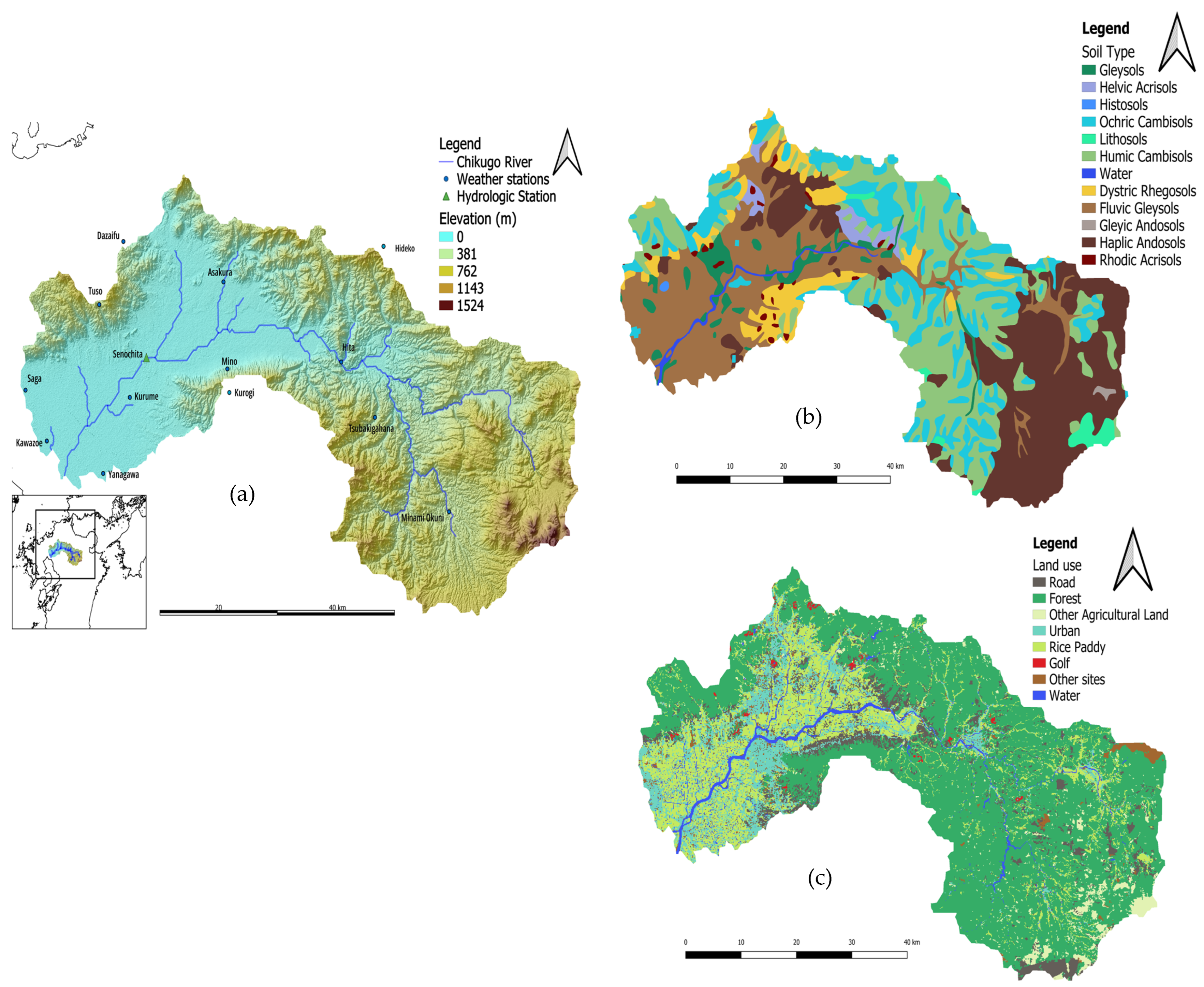
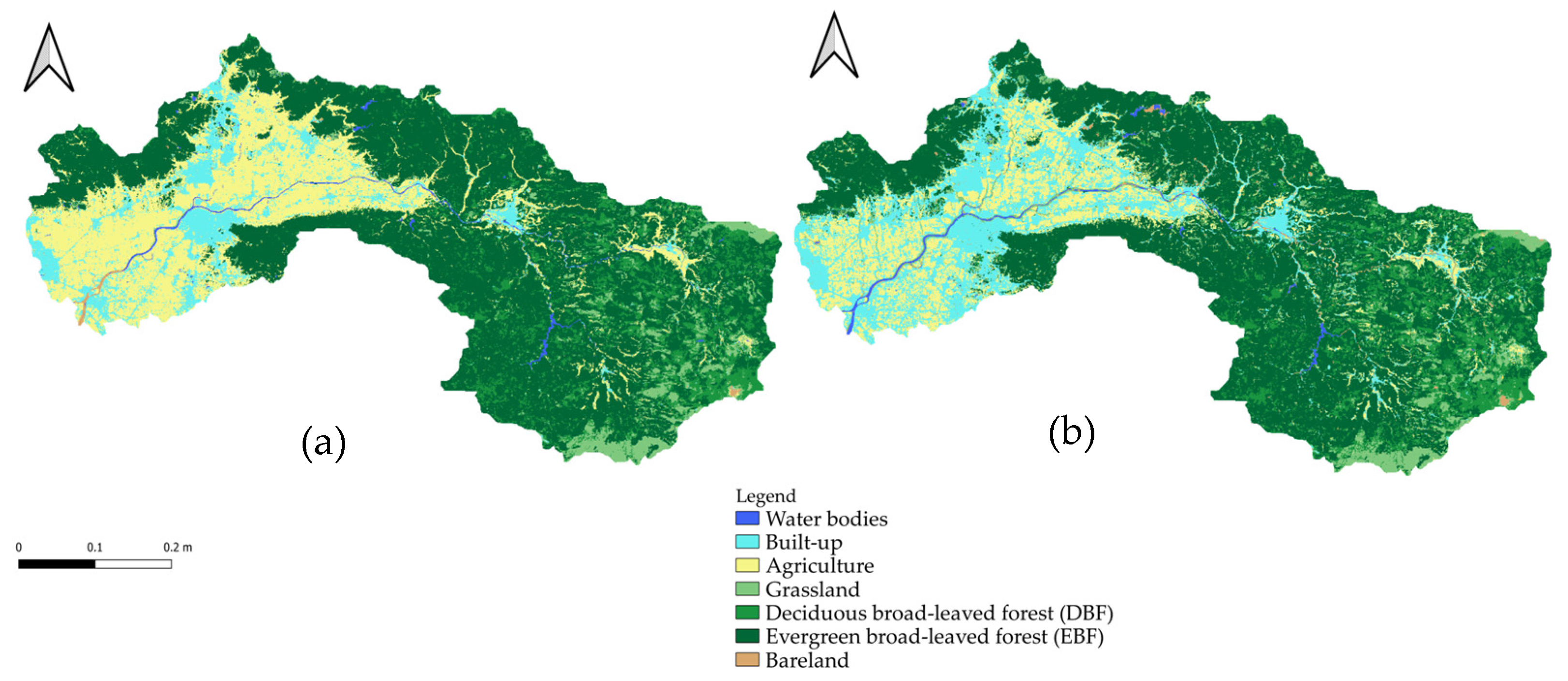
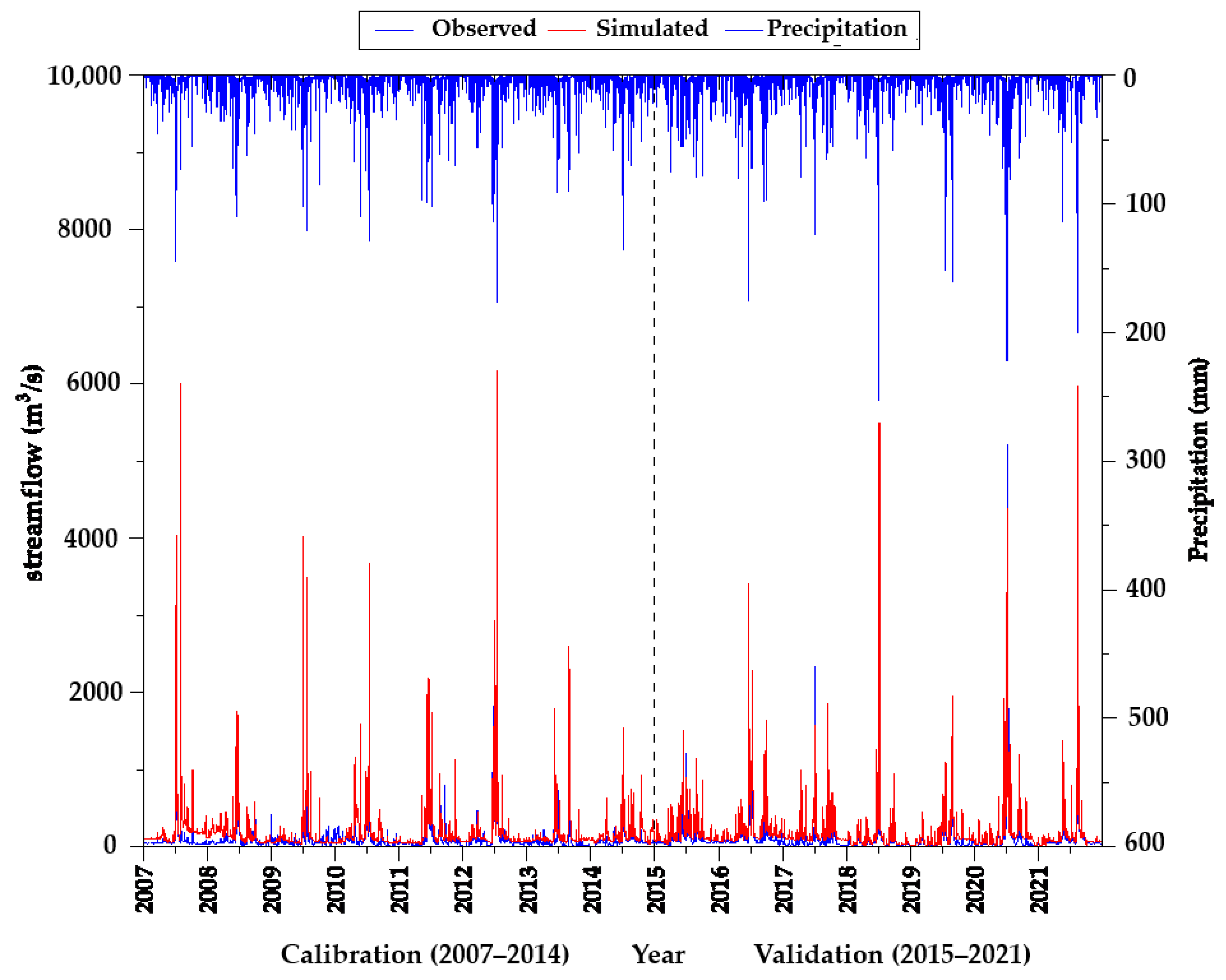
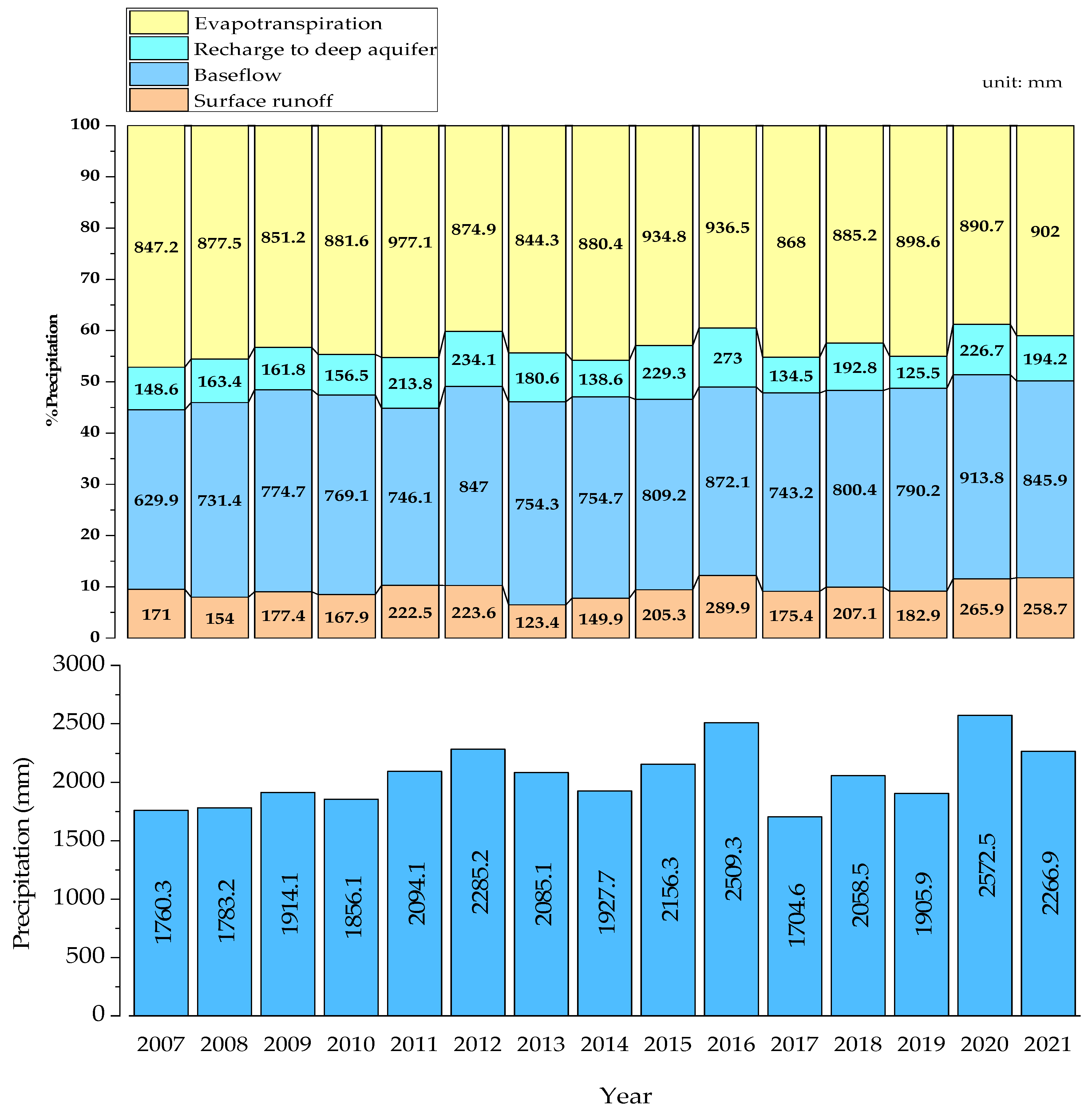

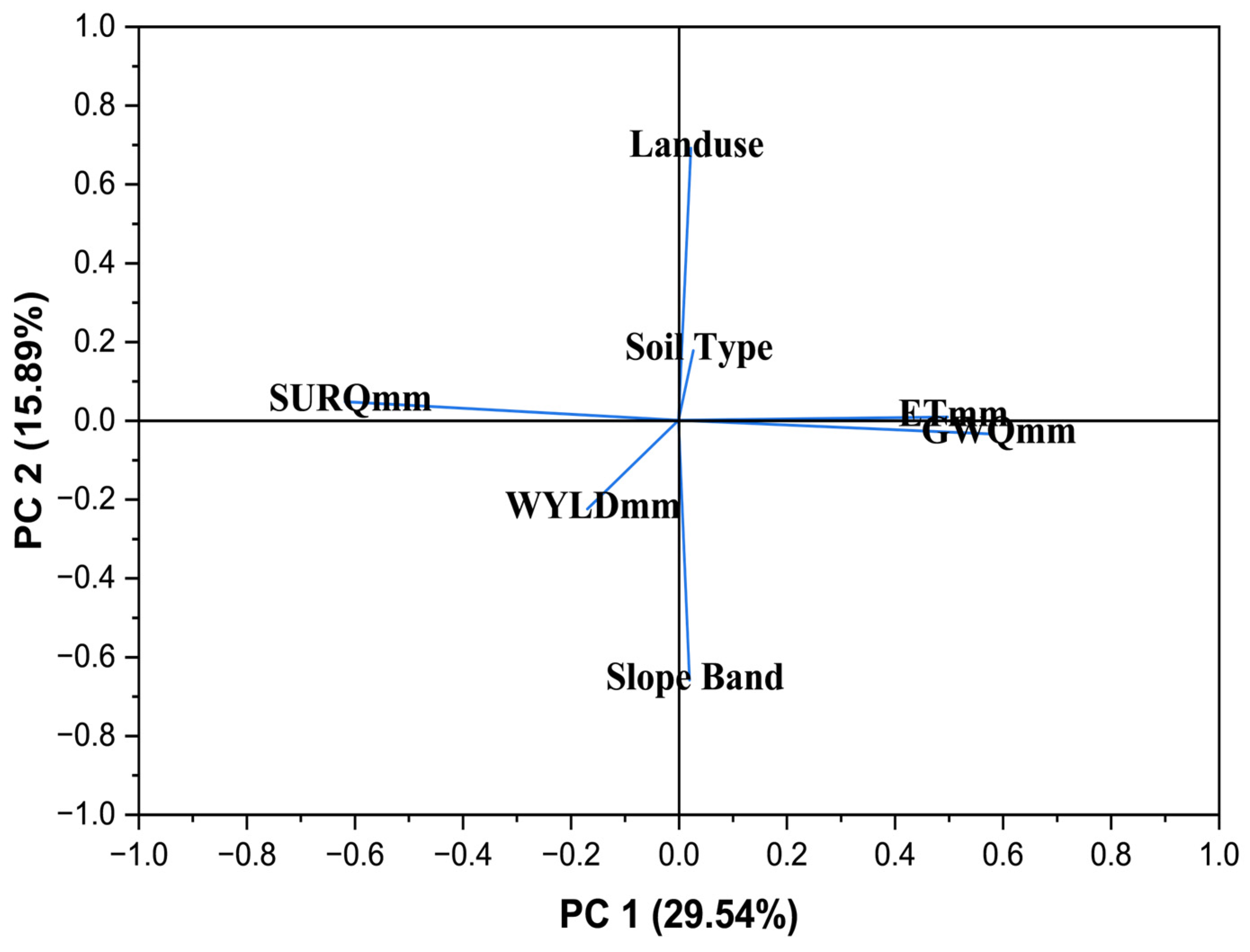
| Data Set | Format | Temporal/ Spatial Resolution | Data Source |
|---|---|---|---|
| Digital Elevation Model (DEM) | raster | 30 m | [19] |
| Soil type | shapefile | 1:500,000 | [20] |
| Land use (2014) | shapefile | 100 m (grid cells) | [21] |
| Weather data | .csv | Daily (2004–2021) | [22] |
| Discharge (m3/s) | .csv | Daily (2004–2021) | [23] |
| Model Performance Evaluation and Uncertainty | Modeling Period | R2 | NSE | PBIAS |
|---|---|---|---|---|
| Calibration | 2007–2014 | 0.81 | 0.81 | −3.6 |
| Validation | 2015–2021 | 0.80 | 0.80 | −5.7 |
| Parameter | File Ext. | Method | Description | Min_ Value | Max_ Value | p-Value | T-stat | Rank |
|---|---|---|---|---|---|---|---|---|
| CN2 | .mgt | r | Initial SCS-CN moisture condition II | −0.003 | 0.088 | 0.000 | 90.56 | 1 |
| CH_N2 | .hru | v | Manning’s “n” value for the main channel | 0.040 | 0.078 | 0.000 | −5.79 | 2 |
| ALPHA_BF | .bsn | v | Baseflow alpha factor | 0.500 | 0.600 | 0.009 | 2.68 | 3 |
| LAT_TTIME | .hru | v | Lateral flow travel time | 159 | 162 | 0.022 | −2.33 | 4 |
| CANMX | .hru | v | Maximum canopy storage (mm) | 32 | 35 | 0.026 | −2.26 | 5 |
| CH_K2 | .hru | v | Effective hydraulic conductivity in the main channel alluvium | 28 | 29 | 0.058 | −1.92 | 6 |
| GWQMN | .gw | v | Threshold depth of water in the shallow aquifer required for return flow to occur | 2230 | 2240 | 0.070 | −1.83 | 7 |
| GW_DELAY | .gw | v | Groundwater delay | 440 | 445 | 0.121 | −1.567 | 8 |
| OV_N | .hru | r | Manning’s “n” value for overland flow | −0.20 | −0.070 | 0.131 | −1.526 | 9 |
| ESCO | .hru | v | Soil evaporation compensation factor | 0.85 | 0.95 | 0.2776 | 1.096 | 10 |
| SOL_K | .sol | r | Soil saturated hydraulic conductivity | −0.057 | 0.129 | 0.288 | −1.070 | 11 |
| HRU_SLP | .hru | r | Average slope steepness | −0.560 | −0.570 | 0.335 | −0.971 | 12 |
| GW_REVAP | .gw | v | Groundwater “revap” coefficient | 9.1 | 9.3 | 0.418 | 0.813 | 13 |
| SLSUBBSN | .hru | r | Average slope length | 0.440 | 0.451 | 0.528 | −0.634 | 14 |
| SOL_AWC | .sol | r | Available water capacity of the soil layer | −0.609 | −0.135 | 0.573 | −0.565 | 15 |
| REVAPMN | .gw | v | Threshold depth of water in the shallow aquifer for “revap” to occur | 751 | 752 | 0.736 | −0.338 | 16 |
| SOL_BD | .sol | r | Moist bulk density | 0.312 | 0.313 | 0.998 | −8.843 | 17 |
| Year | Precipitation (mm) | Water Supply Population (million) | Domestic Water Consumption (mm) | Groundwater Availability (mm) | Domestic water Consumption As a Proportion of Total Groundwater Flow (%) |
|---|---|---|---|---|---|
| 2007 | 1760.3 | 3.52 | 143.6 | 629.9 | 22.8 |
| 2008 | 1783.2 | 3.54 | 145.4 | 731.4 | 19.9 |
| 2009 | 1914.1 | 3.57 | 144.4 | 774.7 | 18.6 |
| 2010 | 1856.1 | 3.58 | 146.8 | 769.1 | 19.1 |
| 2011 | 2094.1 | 3.61 | 147.8 | 746.1 | 19.8 |
| 2012 | 2285.2 | 3.69 | 138.0 | 847.0 | 16.3 |
| 2013 | 2085.1 | 3.70 | 139.0 | 754.3 | 18.4 |
| 2014 | 1927.7 | 3.73 | 137.0 | 754.7 | 18.1 |
| 2015 | 2156.3 | 3.75 | 139.7 | 809.2 | 17.3 |
| 2016 | 2509.3 | 3.77 | 142.0 | 872.1 | 16.3 |
| 2017 | 1704.6 | 3.79 | 145.0 | 743.1 | 19.5 |
| 2018 | 2058.5 | 3.80 | 144.8 | 800.4 | 18.1 |
| 2019 | 1905.9 | 3.82 | 145.0 | 790.2 | 18.3 |
Disclaimer/Publisher’s Note: The statements, opinions and data contained in all publications are solely those of the individual author(s) and contributor(s) and not of MDPI and/or the editor(s). MDPI and/or the editor(s) disclaim responsibility for any injury to people or property resulting from any ideas, methods, instructions or products referred to in the content. |
© 2025 by the authors. Licensee MDPI, Basel, Switzerland. This article is an open access article distributed under the terms and conditions of the Creative Commons Attribution (CC BY) license (https://creativecommons.org/licenses/by/4.0/).
Share and Cite
Macalam, F.J.; Wang, K.; Onodera, S.-i.; Saito, M.; Nagano, Y.; Yamazaki, M.; Nang, Y.W. Hydrological Modeling of the Chikugo River Basin Using SWAT: Insights into Water Balance and Seasonal Variability. Sustainability 2025, 17, 7027. https://doi.org/10.3390/su17157027
Macalam FJ, Wang K, Onodera S-i, Saito M, Nagano Y, Yamazaki M, Nang YW. Hydrological Modeling of the Chikugo River Basin Using SWAT: Insights into Water Balance and Seasonal Variability. Sustainability. 2025; 17(15):7027. https://doi.org/10.3390/su17157027
Chicago/Turabian StyleMacalam, Francis Jhun, Kunyang Wang, Shin-ichi Onodera, Mitsuyo Saito, Yuko Nagano, Masatoshi Yamazaki, and Yu War Nang. 2025. "Hydrological Modeling of the Chikugo River Basin Using SWAT: Insights into Water Balance and Seasonal Variability" Sustainability 17, no. 15: 7027. https://doi.org/10.3390/su17157027
APA StyleMacalam, F. J., Wang, K., Onodera, S.-i., Saito, M., Nagano, Y., Yamazaki, M., & Nang, Y. W. (2025). Hydrological Modeling of the Chikugo River Basin Using SWAT: Insights into Water Balance and Seasonal Variability. Sustainability, 17(15), 7027. https://doi.org/10.3390/su17157027








